| | |
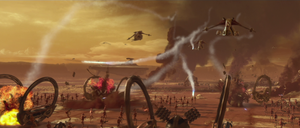
A ground battle between the Galactic Republic and Confederacy of Independent Systems.
Ground warfare related to the use of infantry and ground vehicles to engage other ground units on a planet's surface. Along with space warfare and starfighter combat, by 0 BBY ground warfare was one of the three most significant branches of warfighting. Ground battles and the tactics employed during them were modified throughout the millennia, spanning from the first combats between primitive civilizations to the formation of organized militias and other military forces, to the invention of the blaster and the repulsorlift, to the construction of the first battle droids.
Technology[]
Infantry[]
- "Give me ground troops supported by airpower with supply lines guarded by the navy, and I'll promise you anything. Give me anything else and all I can do is my best."
- ―General Alix Balan

Clone trooper infantry of the Grand Army of the Republic sporting a wide variety of weapons.
By far the most numerous component of any army, infantry were soldiers who fought on foot to close with, assault, capture and occupy enemy positions. Throughout history, infantry had been equipped with a huge variety of weapons, which could be categorized as either ranged weapons or melee weapons. By the period of the Galactic Civil War, the former category was almost universally represented by some kind of rifle, whether a slugthrower or a blaster.[2] Historical examples of ranged weapons (some of which were still used by more primitive species) included thrown spears, bows and arrows, and lanvaroks. While ranged weapons technology had become fairly standardized across the galaxy by 0 BBY, a large number of species continued to use their own traditional weapons or combined them with new technology: Wookiee bowcasters and Chiss charrics were the equals of any Imperial blaster, while despite emerging from a completely different technology base, Gungan cestas, atlatls, and boomas proved more than capable of disabling B1-Series battle droids at the Battle of Naboo. When they invaded the galaxy in 25 ABY, the Yuuzhan Vong brought with them a bizarre array of organic weapons, including amphistaffs capable of spitting venom up to twenty meters, and thud bugs, razor bugs and blast bugs that could be hurled in great swarms at the enemy.[2]
Melee weapons were used when infantry had closed to close-quarters during an assault, and could include knives, swords, polearms and axes. For soldiers of the Imperial Period, vibroblades were the most common melee weapon. An uncommon but nevertheless extremely well-known melee weapon was the lightsaber of the Jedi Knights, which developed a reputation of being able to cut through anything and in the hands of a skilled Jedi, could be used to deflect blaster bolts.[2]
Infantry of the Imperial Period could additionally carry explosive grenades to help clear enemy positions, anti-vehicle or anti-structures missile launchers, sniper rifles to harass the enemy at a distance, area denial weapons like mines, and repeating blasters to suppress the enemy.[2] The most basic infantry tactic was to fix an enemy in position with ranged weapons to allow other soldiers to close with and destroy the enemy in close quarters.
Infantry could also have varying equipment depending on the environment or situation of a ground warfare campaign. For instance, the Stormtrooper Corps had various types of Stormtroopers for varying environments, from aquatic-based seatroopers, to wetland-based swamptroopers, to Geologic-based lavatroopers, to even Radtroopers for heavy radiation zones, with their armor and training being supplied specifically to deal with these situations.[3]
Vehicles[]
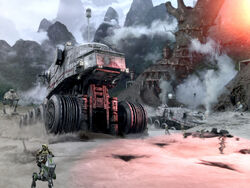
Wheeled vehicles, walkers and repulsorcraft at the Battle of Kashyyyk.
Assault vehicles were used by armies for their mobility, protection and firepower, which could be used to support, complement, and increase the mobility of infantry. Armored fighting vehicles evolved out of the use of animals in war, such as the kaadus of the Gungan Grand Army which served as rapid response shock cavalry, and the war behemoths of the ancient Sith Empire, which marched into battle with massive gun turrets on their backs to smash enemy formations.[1] Even by the Galactic Civil War, animals were still used when environmental conditions made vehicles unusable: the Rebel Alliance made heavy use of scouts mounted on Tauntauns at Echo Base on Hoth.[4]
Vehicles could be categorized based on their form of locomotion, which included wheels, repulsorlifts, and massive armored legs. By the Clone Wars, wheeled vehicles were considered a graceless form of technology from a bygone age, but the wheeled HAVw A6 Juggernaut's direct ground contact protected it against electromagnetic attacks and shield discharges.[5] However, the need for a low-riding chassis impeded the range of their line-of-sight weapons and reduced their terrain-handling capability. Repulsorcraft were typically faster and could handle terrain better than wheeled vehicles and walkers, and could rise above obstacles to give their guns a better aim, but their drive units were easy targets for land mines and missiles with a Gravity-Activated Mode and they could not pass through shield perimeters. Walkers had all the advantages of a wheeled vehicle and could increase the range of their weapons by elevating them on tall legs, but they were typically maintenance-heavy. Thus, an army would use a balanced mix of armored vehicles. According to the Galactic Empire's military doctrine, heavy walkers were best used by elite assault divisions in frontal attacks on enemy fortresses, while repulsortanks and other such repulsorlift vehicles were better suited for "mid-intensity" combat, such as urban warfare and fast-moving campaigns in grassy or forested terrain.[1]
Vehicles could also be classified according to role. Tanks and heavy walkers like the All Terrain Armored Transport were used in frontal assaults against enemy fortifications. Speeder bikes and light walkers like the All Terrain Scout Transport and All Terrain Recon Transport were used for reconnaissance, screening the flanks of an assault, and pursuing retreating enemies.[6] Under the "flying force" doctrine of the last decades of the Galactic Republic, speeder bikes and swoops were popular among regular light cavalry units, including the Single Trooper Aerial Platforms of the Separatist Droid Army and the Biker Advanced Recon Commandos of the Grand Army of the Republic. Troop carriers like the All Terrain Tactical Enforcer, the All Terrain Open Transport, and the Multi-Troop Transport could carry large numbers of infantry into battle under heavy protection and firepower. Militarized airspeeders like the Low Altitude Assault Transport or the V-wing airspeeder could provide extremely heavy close air support to friendly troops on the ground.[1]
Although the term "ground warfare" would generally imply constant use of hovercrafts and more terrestrial-based vehicles, it can also apply to the usage of vehicles and vessels that are more maritime-based in nature should the conflict in question occur on a more aquatic-based planet or simply if the current ground campaign was near water. The Imperial Maritime Division of the Imperial Army was utilized for maritime-based battles during ground warfare which included various vehicles and equipment meant for more aquatic use.[3]
Artillery[]

Republic artillery on Geonosis.
Artillery referred to large weapons designed to fire far beyond the range and power of infantry weapons, and could be immobile, towed, or vehicle mounted. It could include anything from the energy catapults of the Gungans to the most powerful blaster artillery. Artillery included mortars like the Merr-Sonn MM-s3 grenade launcher, which could project fragmentation grenades up to a kilometer, and could be mounted on a WW-676 repulsorlift sled to create a mobile fire support weapon. Anti-infantry batteries like the DF.9 could have a range of up to 16 kilometers, and could be immobile emplacement weapons or mounted on a hoversled to act as a mobile support gun.[7] Anti-vehicle pieces like the AV-7 had built in repulsorlifts, allowing it to be towed until it reached a suitable firing position where it would entrench itself on the ground.[8] By the end of the Galactic Civil War, the New Republic had replaced nearly all its fixed artillery pieces with repulsorlift-equipped units.[2]
Some mobile artillery units were large enough and armored enough to be entirely self-contained vehicles, an example being the SPHA series of the Grand Army of the Republic, which could carry a capital ship-scale turbolaser capable of blasting through the heaviest shielding and fortifications.[9] Because laser cannons were inherently line-of-sight weapons, the SPHA series included a number of indirect fire variants, including the SPHA-C concussion missile launcher and the SPHA-M mass-driver cannon.[10] Further developments in blaster artillery resulted in the development of the MAS-2xB turbolaser by the New Republic era, which was used as a heavy siege weapon in the most important ground battles.[7]
Battle droids[]

B1 battle droids in action during the Battle of Geonosis.
Battle droids were a constant feature of ground warfare throughout history, but their effectiveness on the battlefield varied dramatically. Battle droids were attractive in that an armored droid could withstand far more punishment than an organic soldier, and could carry more weapons than an entire infantry squad. They could also be built, programmed and equipped far more quickly, easily and cheaply than recruiting and training organics. However, droids could be easily out-thought in battle and living beings often proved to be far better at improvising in the heat of battle.[11]
War droids first appeared on the galactic stage with the Rakatan guardian droids of the Infinite Empire.[12] Their most famous early use, however, was in the war-robots of Xim the Despot. The Juggernaut war droids of the ancient Republic was a move to the mass use of battle droids, but development was rapidly halted when they were a key component in the Great Droid Revolution of 4015 BBY. The galaxy thereafter regarded battle droids with fear and revulsion, a perception only increased by the greatest use of battle droids in history during the Clone Wars: the Separatist Droid Army consisted of trillions of B1, B2, droideka, Hailfire and spider battle droids. This was the apex of battle droid use, and thereafter, the Galactic Empire, New Republic and Galactic Alliance would only sporadically resort to the use of battle droids, and then only in very small numbers. Famous post-Clone Wars examples of battle droids like the Dark Troopers and the YVH-Series were exceptions that proved a rather ironclad rule.[1]
Combat support[]
- "COMETS-Q! Yessir, it's COMETS-Q that gets you to the battlefield, sustains you once you're there, and gets you home again!"
- ―Quartermaster Mess Boulanger
Just as important as weapons and vehicles, and without which they could not function, was combat support, including logistics, engineering, communications, and medics. During the Clone Wars, quartermasters and logistics officers used the acronym COMETS-Q to refer to the seven elements of combat support: Chemical, Ordnance, Medical, Engineer, Transportation, Signal and Quartermaster.[13]
Chemical referred to protection measures taken against chemical weapons like Fex-M3 or dioxis. The clone troopers of the Republic and their successors, the Imperial Stormtroopers, wore full suits of sealed white armor to filter out chemical, radiological and biological contaminants.[2] Other militaries issued breath masks for the purpose.[7] Other measures against chemical weapons might include field decontamination centers for affected personnel.[14]
Ordnance referred to the procurement, storage and maintenance of large amounts of ammunition, which could be as diverse as bombs, missiles, blaster gas, blaster power packs, and grenades.[15] Medical referred to procedures for preventing and treating injuries and maladies. It was a truism that throughout military history, disease had killed more soldiers than actual combat. By the Clone Wars this was no longer true, with medical droids like the IM-6 stabilizing injured soldiers in the field, before they were triaged and transferred by medlifter to field medcenters like the Republic Mobile Surgical Units for treatment with bacta, cloned organ replacement, or cybernetic replacement limbs.[16]
Engineer referred to repair, construction and demolition activities made under field conditions.[17] Transportation referred to the shipping of troops and materiel to support the engagement, which could be a complex task that might not always meet the supply demands of troops at the front: at the Battle of Praesitlyn during the Clone Wars, the Republic army consumed 2000 metric tons of supplies per day of operation while resupply could only occur at a rate of 1000 tons per day, and with a high number of transport casualties. Signal referred to military communications made through technology such as comlinks, as well as countermeasures such as jammers. Finally, Quartermaster referred to those military personnel responsible for supply and support.[13]
History[]
Ancient wars[]
- "They polished their fearsome helms, that they might flash even in the weak sun of Notron. They rewrapped the hilts of their weapons and pounded straight the shafts, that they might slake their thirst in Zhell ichor a final time."
- ―Dha Werda Verda
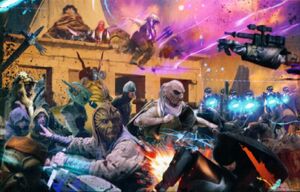
The first ground battles took place between armies equipped with spears and swords, for example, the Taungs and the Battalions of Zhell in their ancient war on Coruscant. Subsequent developments included slugthrowers and wheeled armored vehicles. Technology developing at different paces could create armies using eclectic mixes of equipment: Rakatan infantry of the Infinite Empire were known to go into battle with swords and shocklances while being supported by ancient battle droids equipped with blasters and primitive starfighters.[1][12]
An extremely well-documented ancient military was that of Xim's empire. Xim the Despot's military was extremely advanced for its day, built from lost Rakatan technology. The scale of his armies and conquests meant that numerous examples of Xim's weaponry survived to the Galactic Civil War era. Xim's infantry were divided into several castes. Most were janissaries taken from occupied worlds, trained from childhood to serve as soldiers. They wore armor and helmets of lightweight ceramic alloy and carried either slugthrowers or heatbeams, which used lasers to generate jets of plasma. Heatbeamers wore tough, fireproof padded gloves and kamas a protection against their weapons' superheated exhausts. The kama would later be adopted by the Thyrsus Sun Guard and by the Mandalorian people as part of their culture. Among Xim's elite units were the Duinarbulon Star Lancers, who wore gloss-black ceramic armor and in addition to traditional lances, carried advanced beam tubes, distant ancestors of the blaster. The infantry was supported by tracked tanks, armored groundcars, and floaters armed with beam tube cannons. Elite vehicles were armored with kiirium to reflect energy weapons. Xim's most famous soldiers were the war-robots of the Guardian Corps, three-meter tall battle droids armed with heatbeams, particle dischargers, and pulse-wave cannons. The War-Robots were typically kept in reserve for use as shock troops.[1]
Xim's forces were ultimately defeated in his final war with the Hutt Empire. Little is known about ancient Hutt warriors, but ancient Sakiyan chronicles recorded Hutt cavaliers armored with iron shells and maneuvering via metal limbs, treads or wheels. These would later be compared to the Shell Hutts of Circumtore.[1] At the Third Battle of Vontor, Xim's war-robots and other infantry were overwhelmed by vast numbers of spice-maddened Nikto, Vodran and Klatooinian warriors, spelling an end to the Despot's dominion.[18]
The Wars of the Republic[]

The Great Hyperspace War was fought with both ancient and modern technology.
The early Galactic Republic was founded without an army or navy, but the Tionese War of 24,000-23,900 BBY forced it to become a centralized military power.[1] Throughout its long history, the Republic Army and the Planetary Security Forces would fight many ground battles.
Ground warfare was a perennial feature of the Pius Dea Crusades from c. 12,000 to c. 11,000 BBY. Pius Dea cathedral ships would deploy troops by the millions onto planets that were deemed impure by the religious cult and were to be occupied, plundered and purified. Attritional trench warfare was a feature of these many battles.[1]
During the Waymancy Storm of 7811 BBY, the Republic Military found its best beam tubes, heatbeams and plasma casters entirely outclassed by the pulse-wave blasters of Waymancy Hollow, which used the Sif-Alulan process to create much more powerful, faster firing weapons. Millions died both in space and on the ground before the Republic successfully reverse-engineered Waymancy weapons to create the squintpipe process and its own pulse-wave blasters. Republic Rocket-Jumpers armed with pulse-wave carbines won one of the Republic's first victories in the conflict by routing the Neshtabine nest in the Tantara system.[19] By the 7500s BBY, further advances in the squintpipe process had produced strong, reliable, and portable deflector shields, allowing armies to make use of large planetary shields to protect fortifications. However, ground vehicles were rarely equipped with shields, and personal energy shields faded from military use after the Jedi Civil War: personal shields required large power packs that needed frequent replacement, exposed their users to unhealthy magnetic and radioactive forces, and could fail catastrophically with fatal results.[1]
Blaster technology continued to mature from 7000 BBY, however problems related to pulse-wave weapons' accuracy and range meant that melee weapons were still a decisive component of armies' arsenals, particularly the lightsabers of the Jedi Knights. This was seen most clearly during the Great Hyperspace War of 5000 BBY, when forces of the Sith Empire led by Naga Sadow invaded Coruscant. Sith Massassi warriors fought with pulse-wave rifles alongside their traditional baradiches and lanvarok throwing discs, and cannon turrets crowned the backs of elephantine war behemoths. Throwing discs could skim through deflector shields, and war beasts could stride where armored vehicles could not. The Republic opposed them with blaster artillery supporting armies of spear-wielding infantry, led by lightsaber-armed Jedi.[1]

Republic troops, more heavily armed and armored than their Old Sith Wars counterparts, engage the Sith Imperial Army during the Battle of Alderaan.
The blaster had matured by 4000 BBY and the end of the Great Sith War.[1] By the start of the Mandalorian Wars, the Republic Army would be recognizable to a warrior of the Clone Wars, with a familiar tactical organization, and with uniformly-equipped armored infantry armed with lightweight blaster rifles.[20] Similarly-equipped soldiers and troopers served the Republic during the Great Galactic War, the Cold War, and the Galactic War, fighting against the Imperial soldiers of the Sith Empire. The Sith Imperial Army was also notable for its heavy use of war droids.[21]

The Seventh Battle of Ruusan, where casualties and supply problems reduced the Army of Light to spears and swords in their final battle.
Ground warfare was a feature of the New Sith Wars from 2000 to 1000 BBY. The Republic Army suffered one of the worst defeats in its history in 1466 BBY when the New Sith crushed Republic and Jedi forces in the Battle of Mizra. This bloody conflict was later immortalized by the poet Felloux.[22] Over five hundred thousand soldiers died in the battle and hundreds of Jedi converted to the Dark Side.[23]
Around 1010 BBY, during the last years of the New Sith Wars, the Republic Army was incorporated into the Jedi-led Army of Light under the command of Lord Hoth. In a grueling series of Seven Battles on the planet Ruusan, the Army of Light slowly ground down the Sith Brotherhood of Darkness. By the Seventh Battle of Ruusan, what had begun as an advanced, combined arms army composed of starfighters, speeder bike-mounted infantry, and armored vehicle units had been reduced to a ragtag collection of local levies armed with whatever weapon was available, lending the Army of Light the appearance of a spear-wielding feudal army more appropriate to five thousand years earlier. The Army of Light eventually won a costly victory at the Seventh Battle of Ruusan, when most of the Sith were destroyed by the machinations of one of their own, Darth Bane.[1]
The Rise of the Empire[]

B1 battle droids engage the Gungan Grand Army at the Battle of Naboo.
The Ruusan Reformations of 1000 BBY abolished the Republic's standing armed forces. Nevertheless, ground warfare was an unchanging feature of the Republic's final millennium, conducted by the ground troops of the Judicial Forces and the Planetary Security Forces. In the absence of a centralized military force, the galaxy's greatest megacorporations like the Trade Federation, the InterGalactic Banking Clan, the Techno Union and the Corporate Alliance began establishing their own armies to protect their commercial operations, typically composed of large numbers of battle droids. As relations between the central government on Coruscant and the megacorps slowly collapsed from the 40s BBY through to the start of the Separatist Crisis, these companies began to pursue a massive military buildup, with manufacturers like Baktoid Combat Automata and the Colicoid Creation Nest developing a number of battle droid models designed to wage war against the Republic.[1]
The Battle of Naboo of 32 BBY was the first deployment of large numbers of battle droids by the Trade Federation Droid Army. In a diversionary action fought on the Great Grass Plains, this force engaged with the Gungan Grand Army while Naboo strike teams led by Padmé Amidala infiltrated into occupied Theed to capture Viceroy Nute Gunray. The battle on the plains was of a sort rarely found in galactic society: the Gungans' fambaa shield generators reduced the effectiveness of the Trade Federation's Armored Assault Tanks, and B1-Series battle droid infantry had to be deployed to march through the shield. Consequently, the battle was fought at close range like a traditional land battle between armies largely composed of infantry, and military historians marvelled at the rare opportunity to study such an engagement.[1][24]
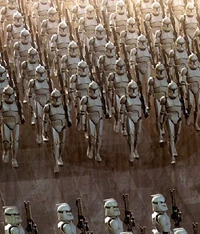
A legion of clone troopers marching in formation.
In the aftermath of the Invasion of Naboo, Jedi Master Sifo-Dyas sensed that the Republic would soon face an existential threat, and approached the cloners of Kamino to produce a clone army for the Republic. A massive mechanized force of clone troopers produced from the Mandalorian bounty hunter Jango Fett, the Grand Army of the Republic was developed in complete secrecy over ten years.[9] Its doctrine and vehicles, ranging from gunships and walkers to assault ships and artillery, were built around unleashing the maximum amount of force incredibly quickly. This differed from the approach seen in ground warfare for thousands of years, where armies had deployed their strength cautiously over long periods.[25] The clone troopers were clad in white full-body armor which protected them against heat, poison gas, impacts, and glancing hits, and were inculcated with Mandalorian warrior traditions by Fett, which proved ideal for reinforcing their genetically engineered inclination toward loyalty and unit cohesion. The Grand Army took the ancient Mandalorian marching chant Vode An ("Brothers All") as its anthem, and took as its motto Darasuum Kote, "Eternal Glory" in Mando'a.[1]
The Clone Wars, beginning with the First Battle of Geonosis, were fought by the Grand Army of the Republic and the Separatist Droid Army across hundreds of different fronts on thousands of worlds. Generally, the Grand Army served as a rapid reaction force while the Republic's disparate Planetary Security Forces operated in defensive deployments - a number of battles in the Clone Wars were fought entirely by Planetary Security Forces without a clone trooper or a battle droid in sight. The GAR's largest operational units were the sector armies, which typically maintained one corps intact as a rapid reaction force while splitting its other three corps into hundreds of small, fast-moving raiding companies.[1] Known as the "militia model", this allowed small numbers of clone troopers to mobilize far larger numbers of local guerrillas and execute planetary coups, a strategy that was successful at the Battle of Malastare, the Battle of Haruun Kal, and the Battle of Giju.[23]
The Separatist Droid Army, meanwhile, was a hodgepodge of vast numbers of different types of battle droids, reflecting the eclectic nature of the factions that made up the CIS. In the initial months of the war, this diverse army worked together poorly, but the Republic was unable to take advantage of the Confederacy's disarray as it faced the same challenge of trying to build up its centralized army while coordinating the efforts of local forces. The Separatists pursued a defensive strategy for the first few months of the war, seeking to blunt Republic drives into their dispersed territories. Its first offensive moves were combinations of surgical strikes and terror operations, a stateless strategy designed to deny the Republic key invasion corridors, undermine support for the war, and sever key fleets' supply lines. Only after a massive military buildup and the appointment of General Grievous as Supreme Commander of the Droid Armies was the CIS able to launch a sustained strike - Operation Durge's Lance - deep into Republic space. By that point of the Clone Wars, however, the Republic had been able to devote its superior industrial capacity to the war. Amid horrific attritional fighting on planets like Mygeeto, Saleucami, Felucia and Boz Pity in the Outer Rim Sieges, the Confederacy was slowly ground down by the Grand Army of the Republic before the deactivation of the Droid Armies by Darth Vader.[1]
The Galactic Civil War[]
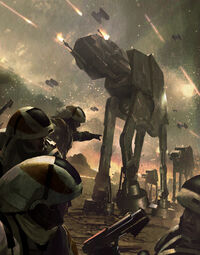
AT-ATs of the Imperial Army in the attack during the Galactic Civil War.
With the Declaration of a New Order, the Republic was reorganized into the Galactic Empire. The clone troopers of the Grand Army became the core of the Stormtrooper Corps, elite shock troops whose loyalty was solely to Emperor Palpatine. Meanwhile, the Planetary Security Forces were nationalized and they and the non-clone humans of the GAR and the Judicials were transformed into the Imperial Army. The human elements of the GAR were specifically placed into the Imperial Army as a means to bring Separatist sympathizers in line, owing to their experience during the Clone Wars, as well as prime itself for surface superiority.[3] Imperial Army troopers garrisoned planets and piloted most of the Empire's ground assault vehicles, including repulsortanks, juggernauts, floating fortresses, and most famously, walkers.> The towering All Terrain Armored Transport had first seen service at the Battle of Jabiim during the Clone Wars, and it and its lighter counterparts like the All Terrain Scout Transport and the All Terrain Recon Transport dominated the battlefield under Imperial Army doctrine. Designed for frontal assaults against enemy fortresses, these walkers were often thought to resemble ancient pachyderm cavalry, as if they had been designed in imitation of the war behemoths of the Sith Empire.[1]
For all their material advantages, however, Imperial Army commanders during the Galactic Civil War were noted to be somewhat uncreative, using outdated "by the book" tactics learned in the Imperial Academy. Most Imperial commanders could be more easily defeated if faced with an unexpected situation for which there was no conventional solution.[15] The Imperial Army's orders generally came from a top-down aspect, whereby the Emperor supplied the orders which were transmitted from Army Command down through a clear hierarchy.[3] In addition, Imperial commanders were expected to follow established protocol, and often did so by set objectives that defined in the type of units deployed into battle and how these units were to be used. As such, while the Imperial forces could afford to field specialized troopers in great numbers and in various formations, their Rebel counterparts in those fields tended to have greater training than Imperial specialists.[3] The Imperial Army had a tendency to ignore complaints from civilians due to answering to the Emperor and not to citizenry, although Imperial Army Special Missions trooper units generally ignored that aspect of protocol.[3] The Imperial Army also had a tendency to treat assets with extreme callousness, such as exploiting their loyalty to the Emperor to be used in no-win combat situations. A particularly notorious example of this was General Rom Mohc's treatment of the Ailon Nova Guard.[3]
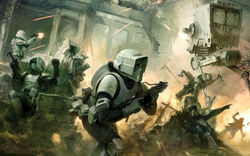
Imperial forces entrenched in a heavy firefight.
The Imperial Army's opposition in the ground warfare of the Galactic Civil War was the far smaller Alliance Army, whose numbers amounted to just 3.5 percent of the New Order's total military forces. In addition, the Rebel forces on most Imperial-occupied worlds could not afford open combat against Imperials because they lacked the troop strength to do so at the regimental level, while the Imperial Army could.[3] However, this was the equivalent to Imperial occupation forces for fifteen sectors, and the Alliance Army was devoted almost entirely to offensive operations. Furthermore, since the Rebel Alliance was for the most part a clandestine insurgency, its strength was more impressive than a direct comparison suggested. Nevertheless, the Rebel troopers of the Alliance Army were a ragtag bunch. Organized into thousands of Sector Forces, they had no common uniform, and differed in every way from how they might organize their units to what equipment was available. Some Sector Forces, like the Airam Clans or the Karthakk resistance, could muster tens of thousands of troops with ground vehicles and artillery. Others had just a few thousand irregulars, saboteurs and agitators with only a few crates of blasters and thermal detonators.[1]
The most capable Rebel soldiers were the Alliance Special Forces, or SpecForce. Optimized for commando warfare and numbering barely one hundred thousand beings, the SpecForces were a flexible backbone for the entire Rebellion. Permanent SpecForce detachments guarded the most significant Rebel bases and barracks regiments acted as specialist support echelons for other elements of the Alliance Military. Most actual fighting was done by temporary task forces assembled on an ad hoc basis for missions, or to bolster weak Sector Forces.[1]
The Alliance's initial war plan, Operation Domino, called for the strongest Sector Forces to defeat local Imperial Army garrisons in set-piece battles and then dig in behind planetary shields, proving that planets could free themselves from the Empire and so inspire a revolution across the galaxy. In the event, Operation Domino was a disaster, and the uprisings were rapidly crushed. Thereafter, the Alliance never tried to take and hold territory until after the Battle of Endor, instead relying on the SpecForces and the Starfighter Corps to strike at the Empire as insurgents.[1] But for when they had to defend against set-piece Imperial attacks on their bases, such as at the Battle of Hoth, Rebel ground warfare consisted overwhelmingly of raids lasting less than a day. Conducting themselves according to General Crix Madine's Rules of War, the Rebel Alliance sought to preserve its limited military resources by using speed and maneuver, psychological warfare and unpredictability, and creatively unorthodox tactics to defeat an Imperial Military overly dependent on superior numbers and doctrinaire thinking.[15]
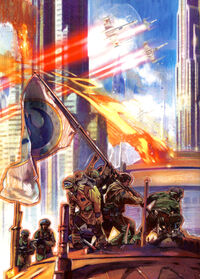
The New Republic Army captures Coruscant.
The Battle of Tiems was a textbook example of Madine's Rules of War: making use of a mobile defense and fighting with three regiments against four Imperial, General Carlist Rieekan successfully drew half the Imperial force into a trap, encircling and destroying them. Though the Imperial commander had another four regiments in reserve, he waited another twelve hours for the weather to clear so his next offensive could be launched with air support, by which time Rieekan had achieved his objective and evacuated his three regiments from Tiems.[15] Elsewhere in the galaxy, the Empire was repeatedly defeated by local forces with superior morale: the Dressellian resistance drove the Empire from Dressel by making heavy use of primitive projectile rifles, which eventually caused the Empire such high casualties that they chose to abandon the planet.[7] At the Battle of Endor, the Imperial Tempest Force was overcome by Ewoks who, despite possessing only primitive weapons, defeat them through superior natural camouflage and terrain knowledge, giving a SpecOps strike team led by General Han Solo time to destroy the shield generator protecting the orbiting Second Death Star, winning the greatest Alliance victory in the Galactic Civil War.[26]
With Emperor Palpatine's death at Endor, the Alliance Army was reorganized into the New Republic Army: the SpecForces were reorganized as bridgehead commandos for planetary assault, while the rest of the Army, composed of the Planetary Security Forces the New Republic had proclaimed denationalized with the Defense Declarations, served as an occupation and peacekeeping force. The Imperial Army and Stormtrooper Corps, meanwhile, suffered badly in the aftermath of Endor, split between ambitious warlords and severely reducing the Empire's ability to resist the advance of the New Republic. Significant post-Endor ground battles included the three-month Milagro campaign, an attritional slog marked by open combat between Republic repulsortanks and Imperial AT-ATs, as well as subterranean struggles between both sides' sappers, miners, and engineers; the savage Battle of Mindor against Lord Shadowspawn; and the Liberation of Coruscant. The New Republic Army suffered heavy casualties in Operation Shadow Hand, however, and in the 12 ABY reorganization of the New Republic Defense Force, was abolished. Many of its responsibilities were transferred to the local defense forces, while the New Republic Marines took over the planetary assault role under the command of the naval battle groups as part of a fully-integrated Defense Force.[1]
Strategy and tactics[]
- "There are three ways to defeat your enemy. The first, and most obvious, is to better him in a trial of force. The best way is to have him destroy himself; few enemies are so obliging. The middle way is to destroy your enemy from within. Judicious application of the middle way shall make your blows more effective if you later take the way of force. From the middle way it is also possible to push your enemy onto the path of self-destruction."
- ―The Sayings of Uueg Tching
Battles on the surface of a planet were conducted by an attacker to seize control of objectives, which could be as small as a single military base to as large as a city or even the entire planet itself. For the attacker, ground warfare comprised the invasion and control phases of a planetary assault operation, and was possessed of numerous advantages, including the ability to supply bombardments or starfighter bombers from an orbiting fleet.[28] The defender also had a number of advantages, however, such as the ability to dig in in entrenched positions or occupy fortresses. As seen in the Battle of Tiems, an invading force might act defensively while a defending force might also act aggressively.[15]
The Imperial Army of the Galactic Empire identified several objectives a ground force might seek to achieve in surface missions include utterly obliterating an enemy possession; engaging enemy infantry and mechanized units; providing strategic insertion of commandos or expeditionary forces; securing control of a key planetary resource or supply line; and holding to a position and destroying enemy attackers attempting to reclaim it. These strategies emphasized demoralizing the enemy, specifically through the use of overwhelming firepower to leave them shell-shocked and helpless in the face of a massive, numerically-superior frontal assault. The Empire also emphasized striking to disrupt the enemy's plans and expose their flaws while they were in disorder. Because of the Rebels' adoption of an insurgent strategy, the Imperial Army saw its first priority as being to eradicate the existence of Rebel cells immediately and decisively, comparing the process to sterilizing a wound with heat.[3] The Imperial Army emphasized the frontal assault as the centerpiece of ground warfare, which drove the development of massive walkers like the AT-AT, which could use its immense height to deliver overwhelming firepower against targets from far outside the range of most artillery or ground vehicles.[1]
The polar opposite of the Empire's mass-, numbers-, and firepower-based tactics were the Rebel Alliance's maneuver-based tactics, which advocated defeating the enemy by incapacitating their decision-making through shock and disruption. Because of the numerical advantage enjoyed by the Empire, Alliance Army commanders were taught to avoid straight-up frontal attacks against the Imperial Army, which could always guarantee victory by bringing in more reinforcements. Instead, Rebel commanders used speed and force concentration to overpower smaller Imperial forces in detail and achieve decisive victory quickly. Furthermore, Rebel commanders were also taught to use psychological warfare to break the enemy's morale prior to battle and encourage in them fear of the Rebel's fierceness and unpredictability, so as to make the enemy more likely to make mistakes such as overreacting to a feint. This form of doctrine encouraged independent thinking in commanders and an emphasis on taking intelligent risks against the enemy.[15]
Ground battles could vary immensely in size and scale: the Battle of Endor was intended as an infiltration raid by a small number of troops in support of the space battle in orbit,[26] while the Battle of Naboo was a series of small engagements to seize control of the Theed Royal Palace while a larger battle was fought on the Great Grass Plains as a diversion and a space battle was fought in support.[24] In contrast, the First Battle of Geonosis involved nearly 200,000 Republic clone troopers and in excess of a million Separatist battle droids and many thousands of vehicles across many miles of ground.[9] In addition, although ground warfare was generally considered a separate form of combat from space warfare and starfighter combat, there have been instances where they had direct interaction. Aside from the noted elements of planetary assault operations, a particularly notable example of combined fronts of space and ground warfare was the Battle of Endor, which featured a combination of both elements.[26]
There are some cases where ground warfare was conducted by accident and was not the intended conflict. A particularly notable instance of this is the Battle of Hoth, where the Imperials intended to launch a bombardment at the Rebel-owned Echo Base at a far enough distance to avoid picking up detection from the Rebel scanners, but the hasty actions of the then-de jure leader of Death Squadron, Admiral Kendal Ozzel, resulted in the Rebel forces generating a planetary shield around the base, forcing the Imperial forces to conduct a costly ground campaign to defeat the Rebel forces, and the Rebels buying enough time for most of their forces to escape.[4]
Notable military commanders[]
Galactic Republic/Jedi Order[]
Sith[]
Confederacy of Independent Systems[]
Galactic Empire[]
Rebel Alliance/New Republic/Galactic Alliance[]
- Carlist Rieekan
- Brenn Tantor
- Tyr Taskeen
- Duron Veertag
- Luke Skywalker
- Airen Cracken
- Bren Derlin
- Crix Madine
Other[]
- Xim the Despot
- Uueg Tching
- Mandalore the Indomitable
- Mandalore the Ultimate
- Canderous Ordo
- Tsavong Lah
- Nas Choka
- Hyndis Raithal
Appearances[]
Sources[]
- The Rebel Alliance Sourcebook
- Shadows of the Empire Sourcebook
- Star Wars: Rebellion: Prima's Official Strategy Guide
 Star Wars: Force Collection (Card: General Veers)
Star Wars: Force Collection (Card: General Veers)- The Essential Guide to Warfare
